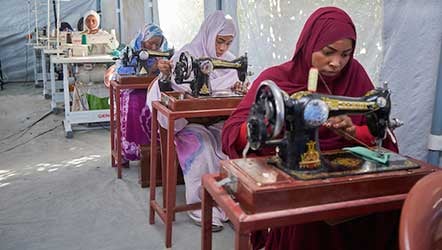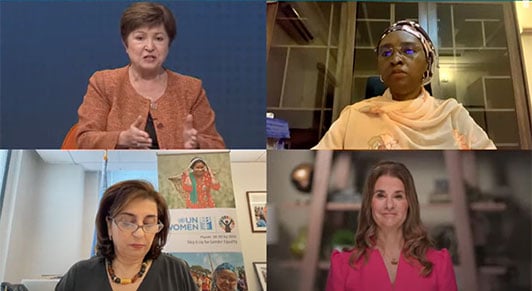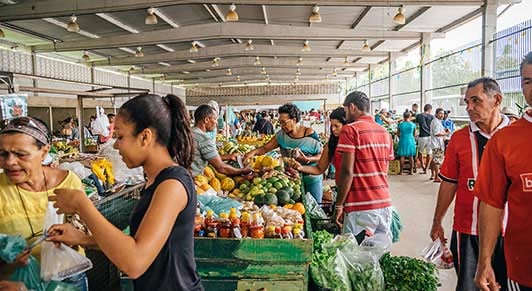Gender

Despite significant progress in recent decades, labor markets across the world remain divided along gender lines. Female labor force participation has remained lower than male participation, gender wage gaps are high, and women are overrepresented in the informal sector and among the poor. In many countries, legal restrictions persist which constrain women from developing their full economic potential. While equality between men and women is in itself an important development goal, women's economic participation is also a part of the growth and stability equation. In rapidly aging economies, higher female labor force participation can boost growth by mitigating the impact of a shrinking workforce. Better opportunities for women can also contribute to broader economic development in developing economies, for instance through higher levels of school enrollment for girls.
How Stablecoins Can Improve Payments and Global Finance
New technology can foster innovation and financial inclusion, or cause fragmentation and turbulence in many countries
Better Economic Measurement Is About Wiser Use, Not Just More Data
Statistics are a means, not an end, that should serve the public by helping us see the world more clearly and make better decisions
Industrial Policy Can Lift Productivity—but Comes With Risks and Trade-offs
Potential gains in targeted sectors and overall are not guaranteed and depend on careful policy design and implementation
How Europe Can Capture the AI Growth Dividend
Artificial intelligence could boost Europe’s productivity, but gains will hinge on efforts to deepen the single market and the calibration of regulation
Policy Actions Can Reinforce Growth Progress in Many G20 Economies
Concerted action on economic reforms can help the G20 achieve the group’s collective growth ambitions, but the reforms with the biggest payoff vary across countries
Sub-Saharan Africa: Steady Growth Amid Fiscal Challenges
Increasing government revenue and better managing debt can help foster resilience and accelerate growth
The Chair’s Summing Up Independent Evaluation Office—IMF Advice on Fiscal Policy Executive Board Meeting December 4, 2025
The Executive Board discussed the Independent Evaluation Office’s review of IMF fiscal policy advice from 2008 to 2023. Directors welcomed the evaluation and noted the Fund’s progress in adapting its guidance to changing global conditions. The discussion highlighted the evolution from a narrow focus on debt sustainability toward a more integrated approach that balances fiscal sustainability, output stabilization, and long-term growth. Directors acknowledged improvements in analytical tools, including debt sustainability frameworks and fiscal risk assessments, while emphasizing the need for clearer articulation of fiscal stance and better integration of long-term spending priorities. The Board reaffirmed its commitment to transparency and consistency in providing candid, country-specific advice to help members navigate fiscal challenges.
Papua New Guinea: Fifth Reviews Under the Extended Arrangement Under the Extended Fund Facility and the Arrangement Under the Extended Credit Facility, Request for a Waiver of Nonobservance of Performance Criterion, and Second Review Under the Resilience and Sustainability Facility Arrangement-Press Release; Staff Report; and Statement by the Executive Director for Papua New Guinea
Papua New Guinea (PNG) is a fragile state with acute development needs, unstable social and political environment, and limited capacity. In the past decade, it faced multiple shocks, including natural disasters, that adversely affected growth, contributed to a sharp increase in public debt, and led to significant shortages of foreign exchange. To rebuild policy buffers and address the country’s long-standing structural challenges, the authorities have steadily implemented a multipronged reform agenda with extensive support from the IMF and other development partners.
Somalia: Fourth Review Under the Extended Credit Facility Arrangement and Request for Augmentation of Access-Press Release; Staff Report; and Statement by the Executive Director for Somalia
Economic activity remained resilient in 2025. However, the outlook is shadowed by the deepening impact of foreign aid cuts and high uncertainty. These are exacerbated by the challenging domestic security situation and political tensions, as well as climate shocks.
Statement by the Managing Director on the Independent Evaluation Office Report on IMF Advice on Fiscal Policy Executive Board Meeting December 4, 2025
The Managing Director welcomes the Independent Evaluation Office’s assessment of IMF fiscal policy advice over the past 15 years. The evaluation highlights the Fund’s evolution from a narrow focus on debt sustainability to a more balanced framework that integrates output stabilization, fiscal sustainability, and long-term growth objectives.
Haiti: Second Review Under the Staff-Monitored Program and Request for Extension-Press Release; and Staff Report
Haiti continues to face exceptional challenges amid a deteriorating security environment and institutional fragility. Gang violence has intensified, undermining state authority and disrupting economic activity. Uncertainty persists over the political transition and the feasibility of holding general elections in 2026. The United Nations Security Council’s authorization to deploy a new Gang Suppression Force and the establishment of a United Nations Support Office for Haiti mark a potential turning point for the country, though security gains will take time to materialize and will require international support.
Philippines: 2025 Article IV Consultation-Press Release; Staff Report; and Statement by the Executive Director for the Philippines
The Philippine economy has achieved successful disinflation on the back of a well-calibrated monetary policy tightening cycle and concerted government measures to reduce food prices. Domestic demand, underpinned by public spending, has been resilient, supporting headline growth. The Philippines is affected by the recent increase in global trade barriers, though its direct exposures remain relatively limited, playing a mitigating role. Growth is expected to remain robust but below its potential in the near term amid heightened external challenges, while inflation is expected to remain muted. Risks are tilted to the downside, stemming from rising global trade barriers and policy uncertainty, while natural disasters continue to pose important macroeconomic risks.
Can Healthy Aging Boost Labor Supply? Evidence from Korea
This paper examines the role of ‘healthy aging’ in boosting labor supply in Korea. First, we use microdata from surveys to assess whether there is evidence that the physical abilities of individuals aged 50 years and above have been improving over successive cohorts. Second, we investigate whether health improvements among older workers influence their labor market outcomes, such as the decision to supply labor or to retire. We use an instrumental variable approach to enable causal inference, proxying exogenous variations in health with the incidence of certain chronic diseases. Our findings reveal that (i) physical health indicators have improved on average across birth cohorts, providing evidence in favor of ‘healthy aging’ in Korea, and (ii) better health increases the probability of participating in the labor force and postponing retirement. Overall, our results suggest that healthy aging has increased the labor supply of older individuals in Korea by around 1.9 percentage points per year during the 2006-20 period. The results for Korea are qualitatively comparable but quantitatively somewhat stronger than those for comparator Asian countries.
Changes in Bank Lending Standards and the Macroeconomy: Evidence from Mongolia
This paper examines the macroeconomic effects of credit supply shocks in Mongolia. Using bank credit surveys and a newly constructed indicator of changes in lending standards, adjusted for macroeconomic and bank-specific factors influencing credit demand, we identify the impact of credit supply disruptions on key macroeconomic variables. Our findings reveal that one standard deviation shock to credit supply leads to an initial reduction in total lending growth, output growth, and inflation. Decomposing the shocks into credit supply components we find that shocks to enterprise and household lending also have similar effects on respective lending growth rates. However, household credit supply shocks have a stronger impact on output growth, while enterprise credit supply shocks have a stronger impact on inflation. Variance decomposition analysis suggests that adjusted credit supply shocks purged from demand fluctuations hold significant power in explaining the variability of macroeconomic variables. Overall, our results confirm the importance of credit supply shocks for macroeconomic variables in Mongolia.
How Stablecoins Can Improve Payments and Global Finance
New technology can foster innovation and financial inclusion, or cause fragmentation and turbulence in many countries
Better Economic Measurement Is About Wiser Use, Not Just More Data
Statistics are a means, not an end, that should serve the public by helping us see the world more clearly and make better decisions
Industrial Policy Can Lift Productivity—but Comes With Risks and Trade-offs
Potential gains in targeted sectors and overall are not guaranteed and depend on careful policy design and implementation
How Europe Can Capture the AI Growth Dividend
Artificial intelligence could boost Europe’s productivity, but gains will hinge on efforts to deepen the single market and the calibration of regulation
Policy Actions Can Reinforce Growth Progress in Many G20 Economies
Concerted action on economic reforms can help the G20 achieve the group’s collective growth ambitions, but the reforms with the biggest payoff vary across countries
Sub-Saharan Africa: Steady Growth Amid Fiscal Challenges
Increasing government revenue and better managing debt can help foster resilience and accelerate growth
The Chair’s Summing Up Independent Evaluation Office—IMF Advice on Fiscal Policy Executive Board Meeting December 4, 2025
The Executive Board discussed the Independent Evaluation Office’s review of IMF fiscal policy advice from 2008 to 2023. Directors welcomed the evaluation and noted the Fund’s progress in adapting its guidance to changing global conditions. The discussion highlighted the evolution from a narrow focus on debt sustainability toward a more integrated approach that balances fiscal sustainability, output stabilization, and long-term growth. Directors acknowledged improvements in analytical tools, including debt sustainability frameworks and fiscal risk assessments, while emphasizing the need for clearer articulation of fiscal stance and better integration of long-term spending priorities. The Board reaffirmed its commitment to transparency and consistency in providing candid, country-specific advice to help members navigate fiscal challenges.
Papua New Guinea: Fifth Reviews Under the Extended Arrangement Under the Extended Fund Facility and the Arrangement Under the Extended Credit Facility, Request for a Waiver of Nonobservance of Performance Criterion, and Second Review Under the Resilience and Sustainability Facility Arrangement-Press Release; Staff Report; and Statement by the Executive Director for Papua New Guinea
Papua New Guinea (PNG) is a fragile state with acute development needs, unstable social and political environment, and limited capacity. In the past decade, it faced multiple shocks, including natural disasters, that adversely affected growth, contributed to a sharp increase in public debt, and led to significant shortages of foreign exchange. To rebuild policy buffers and address the country’s long-standing structural challenges, the authorities have steadily implemented a multipronged reform agenda with extensive support from the IMF and other development partners.
Somalia: Fourth Review Under the Extended Credit Facility Arrangement and Request for Augmentation of Access-Press Release; Staff Report; and Statement by the Executive Director for Somalia
Economic activity remained resilient in 2025. However, the outlook is shadowed by the deepening impact of foreign aid cuts and high uncertainty. These are exacerbated by the challenging domestic security situation and political tensions, as well as climate shocks.
Statement by the Managing Director on the Independent Evaluation Office Report on IMF Advice on Fiscal Policy Executive Board Meeting December 4, 2025
The Managing Director welcomes the Independent Evaluation Office’s assessment of IMF fiscal policy advice over the past 15 years. The evaluation highlights the Fund’s evolution from a narrow focus on debt sustainability to a more balanced framework that integrates output stabilization, fiscal sustainability, and long-term growth objectives.
Haiti: Second Review Under the Staff-Monitored Program and Request for Extension-Press Release; and Staff Report
Haiti continues to face exceptional challenges amid a deteriorating security environment and institutional fragility. Gang violence has intensified, undermining state authority and disrupting economic activity. Uncertainty persists over the political transition and the feasibility of holding general elections in 2026. The United Nations Security Council’s authorization to deploy a new Gang Suppression Force and the establishment of a United Nations Support Office for Haiti mark a potential turning point for the country, though security gains will take time to materialize and will require international support.
Philippines: 2025 Article IV Consultation-Press Release; Staff Report; and Statement by the Executive Director for the Philippines
The Philippine economy has achieved successful disinflation on the back of a well-calibrated monetary policy tightening cycle and concerted government measures to reduce food prices. Domestic demand, underpinned by public spending, has been resilient, supporting headline growth. The Philippines is affected by the recent increase in global trade barriers, though its direct exposures remain relatively limited, playing a mitigating role. Growth is expected to remain robust but below its potential in the near term amid heightened external challenges, while inflation is expected to remain muted. Risks are tilted to the downside, stemming from rising global trade barriers and policy uncertainty, while natural disasters continue to pose important macroeconomic risks.
Can Healthy Aging Boost Labor Supply? Evidence from Korea
This paper examines the role of ‘healthy aging’ in boosting labor supply in Korea. First, we use microdata from surveys to assess whether there is evidence that the physical abilities of individuals aged 50 years and above have been improving over successive cohorts. Second, we investigate whether health improvements among older workers influence their labor market outcomes, such as the decision to supply labor or to retire. We use an instrumental variable approach to enable causal inference, proxying exogenous variations in health with the incidence of certain chronic diseases. Our findings reveal that (i) physical health indicators have improved on average across birth cohorts, providing evidence in favor of ‘healthy aging’ in Korea, and (ii) better health increases the probability of participating in the labor force and postponing retirement. Overall, our results suggest that healthy aging has increased the labor supply of older individuals in Korea by around 1.9 percentage points per year during the 2006-20 period. The results for Korea are qualitatively comparable but quantitatively somewhat stronger than those for comparator Asian countries.
Changes in Bank Lending Standards and the Macroeconomy: Evidence from Mongolia
This paper examines the macroeconomic effects of credit supply shocks in Mongolia. Using bank credit surveys and a newly constructed indicator of changes in lending standards, adjusted for macroeconomic and bank-specific factors influencing credit demand, we identify the impact of credit supply disruptions on key macroeconomic variables. Our findings reveal that one standard deviation shock to credit supply leads to an initial reduction in total lending growth, output growth, and inflation. Decomposing the shocks into credit supply components we find that shocks to enterprise and household lending also have similar effects on respective lending growth rates. However, household credit supply shocks have a stronger impact on output growth, while enterprise credit supply shocks have a stronger impact on inflation. Variance decomposition analysis suggests that adjusted credit supply shocks purged from demand fluctuations hold significant power in explaining the variability of macroeconomic variables. Overall, our results confirm the importance of credit supply shocks for macroeconomic variables in Mongolia.
Promoting Inclusive Growth and Gender Equality
In an era marked by rapid technological advancement and shifting global economic landscapes, the imperative for inclusive growth and gender equality has never been more critical.
International Women's Day 2024
Managing Director Kristalina Georgieva and World Food Programme Executive Director Cindy McCain discussed their personal career journeys, investing in women and girls, and more.
Empowering Women in the Global Economy
Kristalina Georgieva, Melinda French Gates, Hon. Zainab Ahmed, and Sima Sami Bahous discussed how the IMF, governments, and others can work together to help reduce gender gaps.
Toward Peak Population
Senior Advisor on Gender joined a panel discussion on the future of global population growth, and the pressures and opportunities it presents for women and girls.
Women in Finance
Discussion on why more women are needed in the financial sector, especially in leadership positions, and how this can help with financial sector stability and inclusive growth.
Gender Equality
"Gender Equality Boosts Economic Growth and Stability:" remarks by Gita Gopinath, IMF First Deputy Managing Director, delivered at the Korea Gender Equality Forum.
IMF Gender Strategy
At the Center for Global Development, IMF's Ratna Sahay presented the recently approved IMF Strategy Toward Mainstreaming Gender, followed by a panel discussion.















